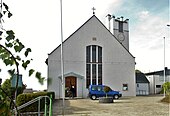Pfandhausen
|
Pfändhausen
dairy farm community Dittelbrunn
Coordinates: 50 ° 8 ′ 25 ″ N , 10 ° 12 ′ 26 ″ E
|
|
|---|---|
| Height : | 367 m |
| Residents : | 579 (December 31, 2012) |
| Incorporation : | May 1, 1978 |
| Incorporated into: | Dittelbrunn |
| Postal code : | 97456 |
| Area code : | 09721, 09725, 09738 |
|
Old church of Pfändhausen
|
|
Pfändhausen (also Milchhof ) is a district of the municipality of Dittelbrunn in the Lower Franconian district of Schweinfurt . Pfändhausen was probably an imperial village .
Geographical location
Pfändhausen is located near the Vorrhön , in the northwest corner of the Schweinfurt Rhön , which here rises to 407 m above sea level. Administratively, Pfändhausen is located in the far north of the very long and narrow Dittelbrunn municipality. Further north begins the Bad Kissingen district with the municipality of Rannungen , Pfändhausen is connected to this place by the district road SW 8 – KG 10. The east is occupied by the Brönnhof , a former US training site in the area of Üchtelhausen , which has been Bavaria 's largest national natural heritage since 2016 . Hambach is to the south , while Holzhausen is to the southwest . In the west, the federal motorway 71 runs past at some distance with the exit Bad Kissingen / Oerlenbach .
climate
The local climate is i. Ggs. To the Schweinfurt basin, which expires 10 km further south-west, noticeably cooler, in winter more often with snow.
history
The place name Pfändhausen goes back to the 8th century. It was then that the Franks began to colonize the region. The name refers to a certain Phention or Phenteo, so that the "Houses of Phention" could be found here. The residents of the surrounding communities also speak colloquially of the dairy farm. The name gives evidence of a large dairy farm in the village, perhaps an important station for the young cattle drive between Bad Neustadt and Schweinfurt was to be found in the village .
The place was first documented in 1307. "Pfentenhusen" was then at a different location, but the village fell into desolation in the 14th century and was rebuilt at its current location. As recently as 1353, Pfandshausen was still a desert area, which the Hennebergers gave as a fief to the Lords of Münster . After the reconstruction, two brothers from the Münster family shared the district among themselves in 1579.
The devastation of the Thirty Years' War also brought great suffering to Pfandshausen. Again the existence of the place was threatened. In 1648 there was only one farm left. It was not until the second half of the 17th century that the village lords succeeded in repopulating the place through the influx of many foreigners. Perhaps the Pfändhauseners even succeeded in ascending to an imperial village on February 8, 1730 , which was directly subordinate to "none other than your Imperial Majesty (...)".
After the dissolution of the Holy Roman Empire through secularization and mediatization by Napoleon , the imperial freedom for Pfändhausen ended, as well as for Sennfeld and Gochsheim in the same district. The place came first to the Electoral Palatinate of Bavaria , before it finally came to the Kingdom of Bavaria in 1814 after an interim period in the Grand Duchy of Würzburg . Centuries of independence as a municipality ended with the municipal reform on May 1, 1978, when Pfändhausen became part of the Dittelbrunn municipality.
Attractions
Today two churches can be found in the center of the village. The older church is consecrated to Saint Anthony of Padua and was built in 1770 on the initiative of the village master Johann Philipp von Münster. It is presented in the Rococo style and has no tower. Inside, the carvings are particularly noteworthy. In the 1960s, population growth led to plans for a new church. It is consecrated to the Holy Cross and was built by Hans Döllgast . Inside, regional artists created some works.
There are also several wayside shrines and small monuments around the village . These religious Flurmale are typical of Catholic communities in Franconia and mostly go back to private foundations. In contrast to the surrounding towns, however, only objects from the 19th century have survived in Pfändhausen. Particularly noteworthy is a large wayside cross with the dying Christ. It was built in 1853.
literature
- Karl-Heinz Hennig: District of Schweinfurt. Northwestern part: art, culture and history. From the Haßberge to the Franconian wine country . Schweinfurt 2008.


